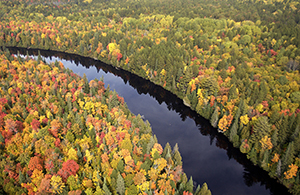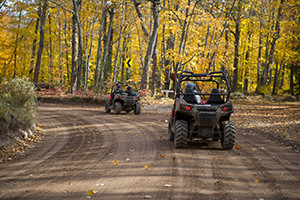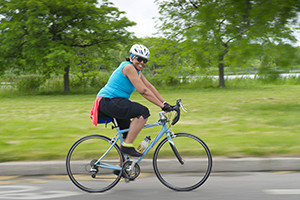The power of public lands – building a strategy for more than 4 million acres
By CASEY WARNER
Michigan Department of Natural Resources
Whether it’s a picturesque Great Lakes shoreline where people flock for a day at the beach, a state forest that’s vital to the timber industry and filled with recreation opportunities for everyone from hikers to snowmobilers, or a game area, park or trail that offers a chance to get close to nature not far from home – chances are, your part of the state has public lands that benefit residents and businesses.
And chances are, the Michigan Department of Natural Resources has a hand in taking care of those public lands, either directly or in collaboration with other agencies.
Caring for public lands

“These are lands where any of us can go and enjoy a number of activities. And the DNR is a big part of that because we partner with locals, we partner with the federal government, and we strategically manage 4.6 million acres of it with a lot of valuable input,” said Scott Whitcomb, DNR senior advisor for wildlife and public lands.
The DNR is responsible for more than 4 million acres of public lands owned by Michigan residents. This includes 3.85 million acres of state forests, 363,000 acres of state parks and 364,000 acres of state game and wildlife areas. It includes places from the tip of the Keweenaw Peninsula to Detroit and everywhere in between.
“These are some of the areas that people often think about – Tahquamenon Falls or Porcupine Mountains Wilderness State Park or Pigeon River Country State Forest – and also areas in southern Michigan like Belle Isle or some of our game areas,” Whitcomb said. “So that’s a big footprint.”
Managing such a large and varied collection of public lands takes a lot of consideration, planning and input.
Public Act 240 of 2012 required the creation of a strategic plan for public land management. The resulting strategy, created in 2013, provides a framework for DNR-managed public lands to ensure their best use for the benefit of Michigan residents and visitors and the state’s natural resources.
As detailed in the 2013 public land strategy, nearly every acre of DNR-managed land is actively managed for multiple uses and values with consideration for timber production, oil, gas and mineral development, fish and wildlife and their habitats, resource protection, recreation, resource functions, cultural significance, and public access.
Now in the process of updating this strategy, the DNR is seeking input from people around the state.
“While the reasons people use and value them vary, one thing remains constant – when public lands are well taken care of, they contribute significantly to the health of Michigan’s residents, environment and economy, in many ways driving our quality of life,” said DNR Director Dan Eichinger.
Benefits of public lands
|

Careful, thoughtful management of these lands ensures plentiful outdoor recreation opportunities across the state, offering residents and visitors places to go off-road, put a boat in the water, hunt, camp, hike, watch wildlife and learn about history – to name just a few options.
The condition and availability of these outdoor spaces close to home are now more critical than ever, with more people out enjoying Michigan’s natural resources during the COVID-19 pandemic.
“Hiking a wooded trail, fishing a trout stream, paddling a lazy river – the comfort provided by these outdoor activities underscores the value of Michigan’s public lands and the need to manage them carefully,” Eichinger said.
People are flocking to public lands in unprecedented numbers, with activities like turkey hunting and visiting state parks seeing significant increases.
Spring/summer 2020 data shows that – compared to the same time frame in 2019 – the number of spring turkey hunters increased 27%, the number of anglers climbed 11%, state park visitation was up nearly 50%, camping and lodging increased 25%, and trail use is at an all-time high, with ORV use up more than 20%.
“Public lands are getting used more than ever,” Whitcomb said. “They offer a chance to get away, social distance, get some fresh air and exercise, and enjoy the health benefits that come with that – getting out in nature helps calm nerves, clear the head and lower blood pressure.”
|

In addition to enhancing quality of life, DNR-managed public lands play a significant role in supporting many aspects of Michigan’s economy, drawing millions of visitors and helping drive Michigan’s $20 billion-plus tourism industry, offering abundant locations for activities like hunting, fishing and wildlife viewing that contribute billions to the state’s economy and supplying timber for the $21 billion-plus forest products industry.
Public lands the DNR manages also strengthen the state’s environmental health, serving functions like air pollution removal, water quality protection and storm water management.
Among the benefits of DNR-managed public land ownership for local communities are payments in lieu of taxes (PILT). The state makes these payments to local units of government in lieu of property taxes for every acre of land owned by the state and administered by the DNR. While these public lands do not require the same level of local government services as private ownership, local communities still see the advantages of the payments. Learn more at Michigan.gov/DNRPILT.
Updating the public land strategy
|

The public land strategy seeks to strike a balance among the many ways these lands benefit Michigan and its residents.
An updated strategy, which must be submitted by July 1, 2021, to the Michigan Legislature for consideration and approval, will explain why a public land base is so important and provide goals, strategies and measurable objectives to guide the DNR in:
- Protecting and preserving Michigan’s natural and cultural resources.
- Providing spaces for quality outdoor recreation opportunities.
- Promoting natural resources management.
As the 2013 strategy explains, “The North American Model of Wildlife Conservation and the Public Trust Doctrine, the foundations that drive the acquisition and management of public lands, both rests on the principle that wildlife and, more broadly, natural resources belong to everyone.”
Because all Michigan residents own the state’s public lands and natural resources, broad participation in the update process is key to ensuring a strong, comprehensive strategy.
“We have 83 counties, 10 million people, and public lands look different depending on where you are – in Iron County versus Wayne County, for example,” Eichinger said. “We’re aiming to manage these lands in a way that benefits all residents and ensures healthy natural resources in all areas of the state, not just rural, not just urban. We want to make sure we’re considering everyone and looking at this plan through the lens of diversity, equity and inclusion.”
Providing feedback
|

The DNR has been gathering input from people around the state and now is encouraging the public to review and provide feedback on newly released draft components.
Two upcoming DNR-hosted virtual meetings – Sept. 30 and Oct. 1 – offer the opportunity to learn more about the strategy, ask questions and provide feedback. See more details about participating in the meetings.
The draft goals, strategies, measurable objectives and key actions – the critical framework for the plan’s next steps – along with other sections of the land strategy are now available for review at Michigan.gov/PublicLands and will be discussed in further detail during the virtual meetings.
For those who are unable to participate, the public meetings will be recorded and made available for viewing on the public lands website, along with additional updates that will be posted throughout the process.
Feedback can be sent to DNR-LandStrategy@Michigan.gov through Oct. 31.
“We want to make sure the voice of Michigan residents is heard,” Whitcomb said. “With your input, and that of people from around the state, we can plug into the power of public lands to help Michigan thrive.”
Learn more about your public lands and the strategy for managing them at Michigan.gov/PublicLands.
|
Check out previous Showcasing the DNR stories in our archive at Michigan.gov/DNRStories. To subscribe to upcoming Showcasing articles, sign up for free email delivery at Michigan.gov/DNR.
/Note to editors: Contact: John Pepin, Showcasing the DNR series editor, 906-226-1352. Accompanying photos and a text-only version of this story are available below for download. Caption information follows. Credit Michigan Department of Natural Resources, unless otherwise noted.
Text-only version of this story.
Biking: A visitor enjoys a bike ride through Belle Park in Detroit.
Family: A fall family outing at Sleeper State Park on Saginaw Bay in Michigan’s Thumb area.
Forest: Public lands the Department of Natural Resources manages include 3.85 million acres of state forest. Pictured here is an aerial view of an eastern Upper Peninsula forest.
Hunting: A hunter and his dog walk through the Pigeon River Country State Forest in the northern Lower Peninsula.
Lighthouse: A scenic view of the Lake Michigan shoreline and the Big Sable Point Lighthouse in the northwestern Lower Peninsula.
Map: A map of public lands managed by the Michigan Department of Natural Resources.
Nature: A family connects with nature at Hoeft State Park, a heavily wooded park in the northeastern Lower Peninsula with a mile of sandy, Lake Huron shoreline.
ORV: Off-road vehicle riders on a trail in the western Upper Peninsula.
Swimming: Visitors enjoy a swim at Dodge #4 State Park in southeastern Michigan, which features a sandy beach and a one-mile shoreline on Cass Lake.
Trail: Hartwick Pines State Park in the northern Lower Peninsula offers a 49-acre forest of old-growth pines to explore.
Wetland: Mallards are year-round residents of Crow Island State Game Area near Saginaw, one of Michigan’s finest wetlands.
|